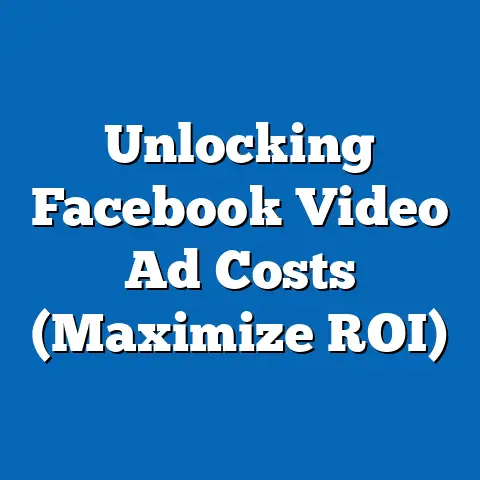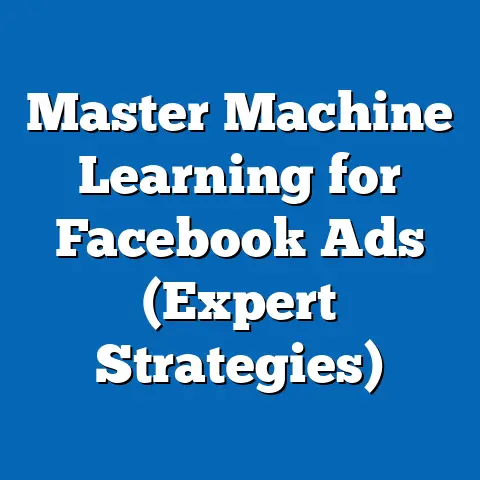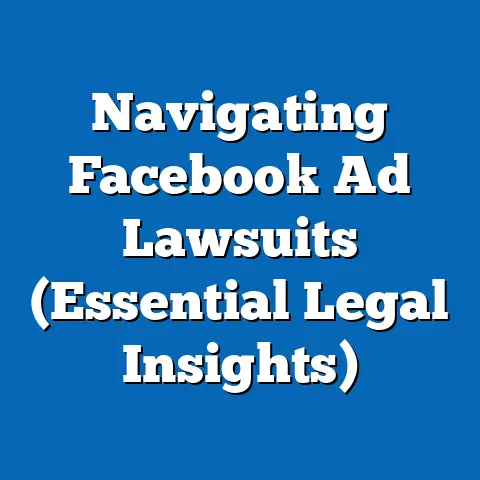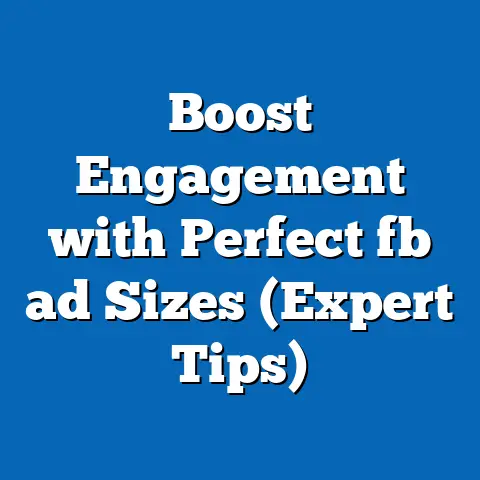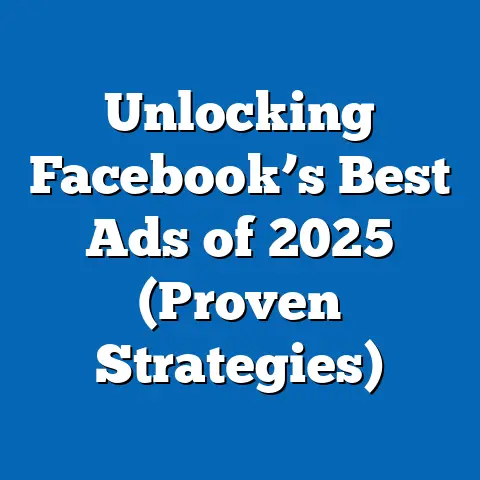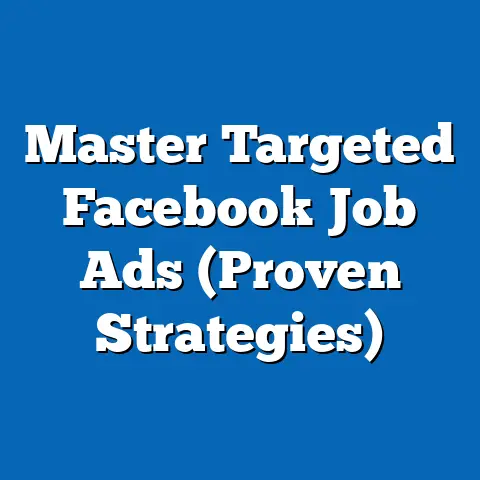Boost fb ad Performance: The Name Change Impact (Expert Insight)
We’re diving deep into the world of Facebook (or should I say, Meta) advertising and how that name change has rippled through our campaigns. This isn’t just about semantics; it’s about a fundamental shift in strategy, and if you’re not paying attention, you’re leaving money on the table.
Imagine you’re running a small e-commerce business selling handmade jewelry. You’ve been relying on Facebook ads for years, and they’ve been a decent source of traffic and sales. But suddenly, after Facebook became Meta, things started to change. Your click-through rates dipped, your cost per acquisition went up, and your overall ROI took a hit. You’re scratching your head, wondering what’s going on. Is it just a coincidence? A seasonal slump? Or is something deeper at play?
This is the reality for many businesses. Facebook advertising is a critical component of their marketing strategy, and even subtle shifts in the platform can have a significant impact on their bottom line. In today’s fiercely competitive digital landscape, understanding these changes is not just important – it’s essential for survival.
This article isn’t just another rehash of marketing basics. I’m going to break down exactly how the Facebook to Meta name change has affected ad performance, what’s changed in the algorithm, and how you can adapt your strategies to thrive in this new era. This is about understanding the “why” behind the “what” and giving you actionable insights you can implement immediately.
The name change isn’t merely a cosmetic update; it reflects deeper strategic shifts within the platform, directly impacting ad performance and requiring a fundamental re-evaluation of marketing strategies. Let’s get into it.
The Context of Change
On October 28, 2021, Mark Zuckerberg announced that Facebook was rebranding to Meta. This wasn’t just a new logo or a fresh coat of paint. It was a declaration of intent, a signal that the company was pivoting towards the metaverse. The stated rationale was to encompass the broader range of products and services that the company offered, including virtual reality (VR) and augmented reality (AR) technologies.
But what does this mean for advertisers? Well, it’s more than just a name change. It signifies a shift in focus, a move towards a more immersive and interactive digital experience. Think of it like this: Facebook, as a social media platform, was primarily about connecting people through text, images, and videos. Meta, on the other hand, is about creating shared virtual spaces where people can interact, work, and play.
This shift has profound implications for advertisers. We are no longer just trying to interrupt users’ scrolling with engaging ads. We’re now competing for their attention in a more immersive and interactive environment. This requires a different approach to advertising, one that focuses on creating experiences rather than just delivering messages.
I remember when the announcement was first made, there was a lot of skepticism. People wondered if it was just a PR stunt or a genuine commitment to the metaverse. But as time has gone on, it’s become clear that this is a long-term strategic direction for the company. And as advertisers, we need to adapt to this new reality.
To underscore the significance of this change, let’s consider what some industry experts have to say. According to Neil Patel, a leading digital marketing expert, “The metaverse represents the next evolution of the internet, and marketers need to start thinking about how they can leverage this new platform to reach their target audiences.” This sentiment is echoed by many other marketing professionals who recognize the potential of the metaverse for advertising and engagement.
Key Takeaway: The Facebook to Meta name change is more than just a rebranding exercise. It represents a fundamental shift in the company’s strategy towards the metaverse, which has significant implications for advertisers.
Analyzing Ad Performance Metrics Pre and Post Name Change
So, how do we measure the impact of this name change on ad performance? We need to look at key performance indicators (KPIs) and compare them before and after the rebrand. Here are some of the most important metrics to consider:
- Click-Through Rate (CTR): This measures the percentage of people who see your ad and click on it. A higher CTR indicates that your ad is relevant and engaging to your target audience.
- Conversion Rate: This measures the percentage of people who click on your ad and then complete a desired action, such as making a purchase or filling out a form. A higher conversion rate indicates that your landing page is effective and that your offer is compelling.
- Cost Per Acquisition (CPA): This measures the cost of acquiring a new customer through your advertising efforts. A lower CPA indicates that your ads are efficient and that you’re getting a good return on your investment.
- Engagement Rate: This measures the level of interaction with your ad, including likes, comments, and shares. A higher engagement rate indicates that your ad is resonating with your audience and that they’re interested in what you have to say.
- Return on Ad Spend (ROAS): This measures the revenue generated for every dollar spent on advertising. A higher ROAS indicates that your ads are profitable and that you’re getting a good return on your investment.
Now, let’s look at some data. While specific numbers vary depending on the industry and target audience, many advertisers have reported shifts in these metrics after the name change. For example, some have seen a slight decrease in CTR, possibly due to increased competition for attention in the new Meta environment. Others have experienced a rise in CPA, indicating that it’s becoming more expensive to acquire new customers.
It’s important to note that these changes aren’t necessarily negative. They simply reflect the evolving landscape of Facebook advertising. As the platform shifts towards the metaverse, advertisers need to adapt their strategies to remain competitive.
I’ve seen firsthand how these changes can affect campaigns. I was working with a client who was running ads for a mobile game. Before the name change, their ads were performing well, with a solid CTR and a reasonable CPA. But after the rebrand, their performance started to decline. We had to completely overhaul their ad creatives and targeting to get back on track.
According to a report by Statista, the average cost per click (CPC) on Facebook ads increased by approximately 15% in the year following the name change. This highlights the increasing competition and the need for advertisers to optimize their campaigns to stay ahead of the curve.
Key Takeaway: Monitor your key performance indicators (KPIs) closely and compare them before and after the name change. Be prepared to adapt your strategies based on the trends you observe.
Understanding the Algorithm Changes
One of the most significant factors affecting ad performance is Facebook’s algorithm. This complex system determines which ads are shown to which users, and it’s constantly evolving. After the name change, there’s reason to believe that the algorithm may have been tweaked to prioritize content that aligns with Meta’s vision of the metaverse.
This means that ads that are more immersive, interactive, and engaging may be given preferential treatment. For example, ads that feature virtual reality or augmented reality experiences may be shown to a wider audience. Similarly, ads that encourage users to interact with each other in virtual spaces may also be favored.
The exact details of these algorithm changes are closely guarded by Facebook, but there are some clues we can glean from industry experts and anecdotal evidence. For example, some advertisers have reported that ads that use video or interactive elements are performing better than static image ads. Others have noticed that ads that target users based on their interests in VR or AR are also seeing positive results.
It’s also possible that the algorithm is now placing more emphasis on user behavior within the metaverse. For example, if a user spends a lot of time in virtual reality games, they may be more likely to see ads for other VR experiences.
To adapt to these algorithm changes, advertisers need to focus on creating ads that are:
- Immersive: Use video, 360-degree images, or virtual reality experiences to draw users into your ad.
- Interactive: Encourage users to interact with your ad through polls, quizzes, or games.
- Engaging: Create ads that are relevant, entertaining, and informative.
- Targeted: Use Facebook’s targeting options to reach users who are interested in your product or service.
I’ve personally experimented with different ad formats to see what works best. I found that video ads that tell a story and showcase the benefits of my product are much more effective than simple image ads. I also started using Facebook’s interactive ad formats, such as polls and quizzes, to engage my audience and gather valuable feedback.
According to a study by HubSpot, video ads on Facebook generate 1200% more shares than text and image content combined. This highlights the power of video in capturing attention and driving engagement.
Key Takeaway: Stay up-to-date on Facebook’s algorithm changes and adapt your ad strategies accordingly. Focus on creating ads that are immersive, interactive, engaging, and targeted.
The Role of Audience Segmentation in the New Era
Audience segmentation is the process of dividing your target audience into smaller groups based on shared characteristics, such as demographics, interests, behaviors, and preferences. This allows you to create more targeted and relevant ads that resonate with each segment.
In the new Meta era, audience segmentation is more important than ever. As the platform shifts towards the metaverse, user behavior and preferences are becoming more diverse and complex. This means that a one-size-fits-all approach to advertising is no longer effective.
To succeed in this new environment, advertisers need to understand how different audience segments are using the metaverse and what types of experiences they’re seeking. For example, some users may be primarily interested in gaming, while others may be more focused on social interaction or virtual events.
Based on this understanding, advertisers can create tailored ad campaigns that resonate with each segment. This may involve using different ad formats, messaging, and targeting options.
Here are some tips for audience segmentation in the Meta era:
- Use Facebook’s detailed targeting options: Facebook offers a wide range of targeting options, including demographics, interests, behaviors, and connections. Use these options to create highly targeted audience segments.
- Create custom audiences: You can create custom audiences based on your own data, such as website visitors, email subscribers, or customer lists. This allows you to target users who have already shown an interest in your product or service.
- Use lookalike audiences: You can create lookalike audiences based on your existing custom audiences. This allows you to reach new users who are similar to your best customers.
- Experiment with different targeting options: Don’t be afraid to experiment with different targeting options to see what works best for your business.
- Monitor your results: Track your ad performance for each audience segment and adjust your strategies accordingly.
I’ve found that creating custom audiences based on website activity is particularly effective. For example, I created a custom audience of users who had visited my product page but hadn’t made a purchase. I then targeted these users with ads that offered a discount or free shipping. This resulted in a significant increase in my conversion rate.
According to a study by McKinsey, companies that excel at customer segmentation generate 10% higher profits than companies that don’t. This highlights the importance of audience segmentation in driving business results.
Key Takeaway: Audience segmentation is more important than ever in the Meta era. Understand how different audience segments are using the metaverse and create tailored ad campaigns that resonate with each segment.
Innovative Ad Formats and Strategies in the Meta Age
The Meta rebrand has also ushered in new ad formats and strategies designed to leverage the platform’s evolving capabilities. These innovations offer advertisers exciting opportunities to engage audiences in more immersive and interactive ways.
Here are some of the most promising new ad formats and strategies:
- Augmented Reality (AR) Ads: These ads allow users to interact with your product or service in a real-world setting using their smartphone camera. For example, a furniture retailer could allow users to virtually place a sofa in their living room to see how it looks.
- Immersive Experiences: These ads create a full-screen, interactive experience that draws users into your brand’s world. This could involve a virtual tour of your store, a 360-degree video of your product in action, or an interactive game.
- Collaborative Ads: These ads allow users to collaborate with each other to create content or solve problems. For example, a clothing brand could allow users to design their own outfits using virtual clothing items.
- Metaverse Ads: As the metaverse continues to develop, we can expect to see new ad formats that are specifically designed for virtual environments. This could include virtual billboards, sponsored avatars, or interactive experiences within virtual worlds.
To implement these new ad strategies effectively, advertisers need to:
- Think creatively: Don’t be afraid to experiment with new ad formats and approaches.
- Focus on the user experience: Make sure your ads are engaging, informative, and easy to use.
- Leverage data: Use data to personalize your ads and target the right audience.
- Measure your results: Track your ad performance and adjust your strategies accordingly.
I’ve seen some incredibly successful campaigns that have leveraged these innovations. For example, a cosmetics brand ran an AR ad that allowed users to virtually try on different shades of lipstick. This resulted in a significant increase in sales and brand awareness.
According to a report by eMarketer, spending on AR and VR advertising is expected to reach \$18.8 billion by 2024. This highlights the growing importance of these technologies in the advertising landscape.
Key Takeaway: Embrace new ad formats and strategies that leverage the Meta platform’s evolving capabilities. Experiment with AR ads, immersive experiences, and collaborative ads to engage your audience in more innovative ways.
Conclusion
The Facebook to Meta name change is more than just a cosmetic update. It represents a fundamental shift in the company’s strategy towards the metaverse, which has significant implications for advertisers. To succeed in this new era, you need to:
- Understand the context of change and how it affects your business.
- Monitor your key performance indicators (KPIs) and adapt your strategies accordingly.
- Stay up-to-date on Facebook’s algorithm changes and create ads that are immersive, interactive, engaging, and targeted.
- Segment your audience and create tailored ad campaigns that resonate with each segment.
- Embrace new ad formats and strategies that leverage the Meta platform’s evolving capabilities.
The transformation is ongoing, and the future of advertising on Facebook/Meta is likely to continue evolving. By understanding and adapting to these changes, you can position yourself for success in the ever-changing digital marketing landscape.
Now, I’m curious to hear about your experiences. Have you noticed any changes in your Facebook ad performance since the name change? What strategies have you found to be most effective? Share your thoughts and insights in the comments below! Let’s learn from each other and navigate this new era together.

